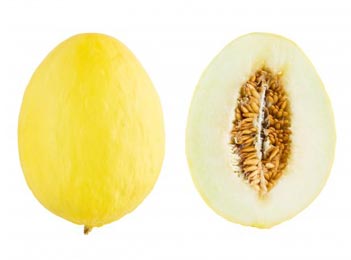Canary Melons: A Complete Guide to Taste, Nutrition, and Selection
- By FruitGuys Staff
- Reading Time: 3 mins.
 Picture this: You’re listening to The Mills Brothers’ “Yellow Bird” as you cut open a juicy Canary Melon. The dreamy music and bright yellow fruit bring a tropical summer feeling right into your kitchen. The inside of the melon is cool white tinged with pale green, and its honeyed scent promises sweetness. Your mouth is watering: You’ve made it to Canary melon wonderland!
Picture this: You’re listening to The Mills Brothers’ “Yellow Bird” as you cut open a juicy Canary Melon. The dreamy music and bright yellow fruit bring a tropical summer feeling right into your kitchen. The inside of the melon is cool white tinged with pale green, and its honeyed scent promises sweetness. Your mouth is watering: You’ve made it to Canary melon wonderland!
What Are Canary Melons?
The Canary melon is a large, oval-shaped fruit with mysterious origins. The Smithsonian Magazine claims that it hails from the Canary Islands, while other accounts trace it to the Middle East near modern-day Iran. It’s unclear whether the melon’s name is a reference to the islands or the bird that shares its bright yellow color. Either way, there’s no doubt that it’s a delicious spring and summer treat.
The Canary melon transforms as it ripens, its skin turning a vivid yellow with a smooth, waxy feel. Inside, its white or pale green flesh has a soft, creamy texture similar to a ripe pear. The melon’s flavor is delightfully sweet, with hints of banana and pineapple and a mellow, musky finish.
The Nutritional Profile of Canary Melons
The Canary melon is a treasure trove of nutrients, offering dietary fiber for digestive health and Vitamin C to boost your immune system and reduce inflammation. It’s also rich in Vitamin A, which keeps your organs healthy, and potassium, which helps balance the fluid in your cells.
Not impressed yet? You’ll also find manganese, iron, calcium, phosphorus, pantothenic acid, zinc, Vitamin B6, magnesium, and omega-3 and 6 fatty acids hidden in each juicy bite.
The Health Benefits of Canary Melons
Because of the nutrients listed above, snacking on Canary melon slices can bring a surprising number of health benefits. Here are just a couple of them.
Healthy Eyes
Canary melons naturally include vitamins A and C, which contribute to healthy vision and proper cornea function.
A Stronger Immune System
The vitamins and minerals in Canary melons can help strengthen your immune system and reduce inflammation, keeping illnesses at bay.
Canary melons are also low in calories, fat-free, and vegan, so they’re a healthy snack for almost every diet and lifestyle.
Culinary Uses
Canary melons shine in various culinary creations, from fresh, crisp salads and salsas to fruity smoothies. Try tossing slices on the grill or drizzling them with olive oil and sprinkling them with oregano, basil, or mint. For a refreshing treat, you can even make Canary melon sorbet! Add frozen cubes of melon and ice to a blender along with fresh fruit juice and your favorite sweetener.
Picking the Best: How to Select Ripe Canary Melons
For peak flavor, choose melons that weigh four to five pounds and have bright yellow skin. Avoid green melons, as they won’t mature off the vine. A ripe Canary melon will smell sweet and feel a bit soft at the bottom.
If you want to enjoy ripe Canary melons and other fresh fruits without the hassle of picking them yourself, The FruitGuys has you covered. Check out our seasonal fruit delivery boxes bursting with farm-fresh goodness.
FAQs
- Can I eat the seeds of Canary melons?
Yes, the seeds are edible. You can even roast them for a crunchy snack!
- How should I store my Canary melons at work or at home?
Store your melons at room temperature until you cut them. After you dig in, stash the leftovers in an airtight container or wrap them in plastic and refrigerate them for up to five days.
- When are Canary melons in season?
The peak season for canary melons is late spring through summer.


